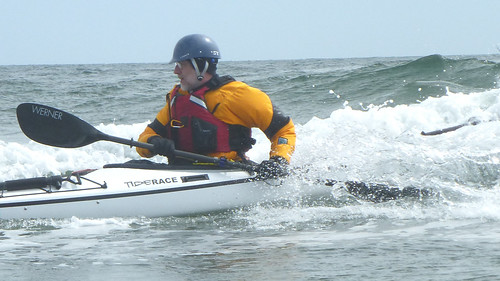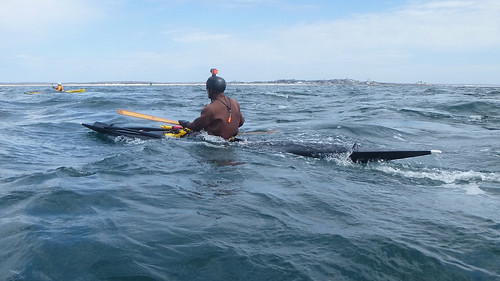Posted by: Ken Bolton 12 years, 3 months ago
Paul and I spent April 7 paddling out of Stonington, CT, to Catumb Rocks to catch the peak of the ebb tide and ride the waves that pop up at the ledge between Fisher's Island, NY, and Napatree Point, RI. We met our coaches, Paula and Greg from Kayak Waveology, at Noah's in Stonington at 8:30 for coffee and second breakfasts, having departed Beacon before daybreak. We met our classmates. Josko is a paddler out of Wood's Hole, MA. Ivan came from Kingston, NY. Greg and Paula showed us the excellent Android Currents app. Predicted maximum current was ebbing at 2.2 knots 11:52 AM 0.7 miles (nautical?) southwest of Napatree Point.
Let me back up here a moment. When I called Greg a week ago to arrange the coaching, he asked what boat I was bringing. I told him that I planned to paddle my Black Pearl. I could immediately hear some concern over the phone, when he asked about paddling such a low-volume boat. And that made me doubt. It made me doubt my gear, my ability, and my ability to gauge my ability. I spent a lot of the week agonizing over it. Paul and I went out in a stiff breeze and bitterly cold conditions the Wednesday before. I wore the gear, including a helmet, that I anticipated wearing for our bluewater trip. By Friday, I was back to my usual cautious optimism. There must have been some residual anxiety, though, because I only slept a handful of hours Saturday night.
I believe we first set course for the mast at 41º17'30"N 71º54'10"W just east across Lords Passage from Wicopesset Island. Check out this chart. On our way out, we did some drills to practice skidding and carving turns. Greg pointed out that my low back deck appeard to act like a skeg when carving and prevented the boat from turning. I mentioned that the boat, when carved aggressively, would simply skid unless I applied pressure with my paddle on the center of my imagined turn radius, so I generally just skid.
We surfed the tide race as the water in the Long Island Sound made every effort to squeeze through the submerged rocks as it poured back into the Atlantic. A 15 knot breeze from the south helped the waves stand up a little. I was able to link a few rides up the wave-train into the ebbing tide. At one point, i found myself on a small standing wave, just enough to point my nose down and let me carve back and forth. Greg and Paula, independently, warned me about the "wall" I would encounter trying to roll up on the upstream side, and that I should try to roll up on the downstream side instead.
So why the concern from the coaches? A few reasons, naturally. They did not know me or my skill level. They asked if I had a roll, and they saw that I had the appropriate safety equipment, so certain assumptions about "seriousness" can be made. A long, skinny boat like the BP can require a lot of work to keep upright, leading to exhaustion. I have been at that point in a Greenland kayak. Near-absolute exhaustion, where the muscles that keep you upright are so tired you have to lay the boat on its side and float in order to save energy, rest, and recover.
We beached on Napatree Point to enjoy a chilly lunch with some local paddlers. Among these was Nick Schade of Guillemot Kayaks. He was paddling his Petrel Play. Looks like a fun boat! Building a strip kayak is definitely in my future, and the Play looks like a boat that could nicely round out my quiver. While on shore, we talked about where strokes should end depending on the shifting center of gravity front-to-back. When leaning far forward, the stroke must exit the water earlier to take advantage of the bow buried deeper in the water.
The air was quite cold, so we jumped back into our boats and paddled around the Point to a spot affectionately known as The Molars. A line of low rocks off the tip of Napatree Point, The Molars has surf when the conditions are right. I believe Jon Stockdill and I may have paddled through them when we did a Napatree Point trip a few years ago. The surfing was great, and we lined up with Nick's crew to take turns in the surf zone. I caught a few good waves, and even managed to link a few, I think. We talked about watching the waves ahead of you to help anticipate what the wave you are on will become, and Greg had us practice stern pries to "counter-steer" (my words) the boat. I remember doing that when surfing in a white-water boat, but had no success nailing it in the surfzone.
David Grainger got some great photos that he generously posted to his Flickr stream.
Paul looks very strong above, and you can tell that he is really moving through the water.
The water is surging up over my back deck.
Greg commented on how strong my torso rotation was, with my paddle and shoulders parallel.
On the way back to terra firma, we practiced more carving turns, and linking skids with carves.
Greg mentioned two Greenland paddle techniques that I need to experiment with. Maligiaq's "crunch" technique is what I have been doing, but there is a top-hand pushing element I can incorporate for more power. The other technique is, if I understand it, similar to the technique used with a wing paddle. This may help.
Question: How do great paddlers keep their technique in the off-season? Answer: Do not have an off-season!
Share on Twitter Share on FacebookRecent Posts
- Bannerman's Early Morning
- Long Dock to Bannerman's Island
- Long Dock to Denning's Point
- Long Dock to the Moodna Creek and Back
- Tide Race and Overfall Training
Archive
2013
2007
- September (5)
Categories
- Paddle Trip Log (5)
- devops (2)
Authors
- Ken Bolton (15)



Comments